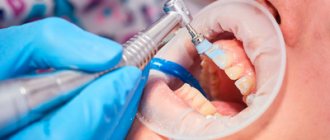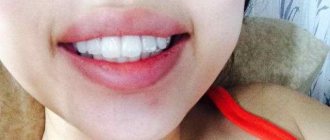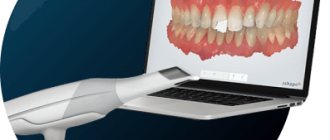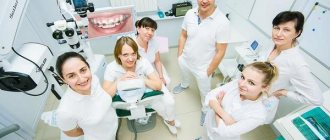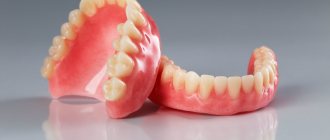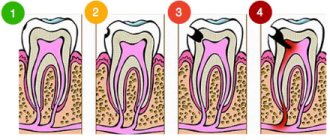Scope of activity of an orthodontist
The main task of an orthodontist is the correction of malocclusions6,10, which have an extremely adverse effect on the health of the oral cavity and the body as a whole2,8. It also corrects unevenness of the dentition and individual teeth, dentofacial and maxillofacial anomalies10.
Preventive measures taken by the orthodontist are aimed at preventing the development of the above problems and eliminating risk factors10.
The responsibilities of the orthodontist also include the prevention of complications arising from malocclusion2:
- dysfunction of the temporomandibular joint;
- difficulty breathing;
- changes in diction;
- headaches;
- digestive problems.
Even in the absence of serious defects, many strive to have a Hollywood smile and absolutely straight teeth, so the services of an orthodontist are quite in demand.
Orthodontics and orthopedics in dentistry difference
The biggest difference, perhaps, is that in addition to an orthopedic dentist, there is also a general orthopedic surgeon.
Next, the orthodontist sets the teeth in their places, aligns the bite, but does not affect the shape of the teeth themselves.
An orthopedist uses dentures to restore teeth and replace lost teeth, thus restoring chewing function and psychological comfort.
In general, there is quite a big difference between orthopedics and orthodontics in dentistry; specialists deal with completely different treatments and we hope that now you will not confuse them.
What treatment methods does the orthodontist use?
There are various methods of orthodontic treatment. The most common of these is hardware3. It involves the use of various designs - removable and non-removable3,11 - with which you can9:
- expand or narrow the dentition;
- speed up or slow down the rate of jawbone growth;
- change the position of individual teeth and the position of the lower jaw.
The devices that the orthodontist works with include:
- Braces are a non-removable system that is fixed on the teeth3,9. It includes the braces themselves, rings, locks and arches3. These elements put pressure on the teeth, moving them in the desired direction3. The method is considered one of the most effective, which is why braces are used to correct most malocclusions4.
- Plates are removable devices with various active elements (screws, springs, hinges). They permanently or intermittently attack the teeth and jawbone3. Plates can be placed at any age, but the best age is considered to be 6-9 years11.
- A pre-orthodontic trainer is a removable elastic aligner that is usually placed at night3. It improves the position of teeth and normalizes breathing, swallowing and muscle tone1.
- Aligners are transparent aligners made of a special thermoplastic material5. They are made after computer 3D modeling of human jaws5, which allows you to see the final result even before they are installed. Aligners should be worn 24 hours a day, removed when eating and brushing teeth, and replaced with new ones every 2 weeks7.
Bottom line
Orthopedics is a branch of medicine that deals with issues of the musculoskeletal system. Orthopedics in dentistry deals with the problem of restoring chewing and speech functions, returning the patient to the ability to fully chew food and talk with people. If any number of teeth are lost, the patient seeks help from a prosthetist. The choice of dentures depends on the financial capabilities of the patient, the clinical picture, and the equipment of the dental clinic.
The best option is to install implants with subsequent fusion with bone tissue. Such structures protect bone mass from atrophy and completely replace tooth roots. Removable and fixed dentures are cheaper than implants, but do not protect bone and gum tissue from atrophy and loss. The choice of prosthetic method also largely depends on the condition of the patient’s oral cavity: for many, bridges or other structures are contraindicated due to malocclusion, pathology of bone or gum tissue.
Sources used:
- Abolmasov, N. G. Orthopedic dentistry. - Moscow: MEDpress-inform, 2007.
- Lebedenko I. Yu., Kalivradzhiyana E. S. Orthopedic dentistry: textbook. — Moscow: GEOTAR-Media, 2012.
- Wikipedia article
When to see an orthodontist
Some people mistakenly believe that bite correction can only be done in childhood or adolescence. But most of these problems can be solved at any age,2 which is why adults with uneven teeth and malocclusions should consult an orthodontist.
Considering that the appearance of malocclusion pathologies can be prevented already in early childhood, it is better to regularly show the child to the orthodontist, even if his teeth seem straight1. When examining children, the orthodontist draws parents' attention to factors that interfere with the correct formation of the bite. The doctor gives recommendations on how to properly monitor the baby’s diet, breathing and sleep. Normalization of these functions has a beneficial effect on the development of the dental system and the entire organism as a whole1.
Orthodontic treatment is carried out comprehensively, combining the work of a dentist-therapist, an orthopedist and surgeon, a speech therapist, an otolaryngologist and other specialists. However, the leading role belongs to the orthodontist. He develops a comprehensive plan for the prevention and treatment of dental anomalies, coordinates the work of other doctors and conducts follow-up2.
The information in this article is for reference only and does not replace professional advice from a doctor. To make a diagnosis and prescribe treatment, consult a qualified specialist.
to come back to the beginning
Dentist Orthopedist
In dentistry, an orthopedist specializes in restoring damaged teeth and replacing missing teeth. He does this with the help of prosthetics, which is why an orthopedist is also called a prosthetist.
You should contact an orthopedist if you notice:
- Loss of one or more teeth
- Decay of teeth that cannot be filled
- Too loose or sensitive teeth
- Aesthetic dissatisfaction with your teeth - an orthopedist can correct the color, shape and size of teeth
- Pathological conditions of the TMJ
Dentists of other specialties are often referred to an orthopedist; for example, when a tooth is more than half destroyed, therapists say that it is not practical to restore such a large defect with a filling and refer you to an orthopedist to install an inlay or crown.
Bibliography
- Bogdan V. E. et al. Prevention of dental anomalies and orthodontic treatment at an early age // Chief Doctor of the South of Russia. - 2013. - No. 6 (37). — P. 4-6
- Kyzina S. L., Rebrova A. E. Orthodontics for everyone // Healthcare of Ugra: experience and innovations. — 2022. — No. 4. — P. 33-38
- Tokarevich I.V. General orthodontics // Educational method. allowance. — Minsk: BSMU. - 2015. - 80 p.
- Khotayt A. Kh., Butvilovsky A. V. Method of manufacturing a non-removable individual retainer // Orthodontics gnathology. — 2022. — November. — No. 2 (3). — P. 22-26
- Kipkaeva L. V., Belkevich V. V. Application of the aligner system in the treatment of dentofacial anomalies in the permanent dentition. Design features. Treatment effectiveness // Orthodontics gnathology. — 2021. — April. — No. 1 (4). — P. 50-55
- Bulgakova A.I. et al. Structure and equipment of dental organizations // Textbook. - Ufa: Publishing house of the Federal State Budgetary Educational Institution of Higher Education BSMU of the Ministry of Health of Russia. - 2016. - 84 p.
- Ganjali N. T. Braces or aligners? // Bulletin of medical Internet conferences. — 2014. — T. 4. — No. 4. — P. 370
- William R. Proffitt et al. Modern orthodontics // Textbook. — 686 p.
- Demina M.A. Positive and negative aspects of working with orthodontic structures, selection criteria // Bulletin of medical Internet conferences. - 2022. - T. 7. - No. 9. - P. 1440-1442
- Alimirzoev F.A. Modern ideas about complex treatment in orthodontics // Achievements of university science. — 2014
- Shkavro T.K., Pavlova I.A. Orthodontic devices // Textbook. – Irkutsk: IGMU. — 2022. — 32 p.
A little bit of history
The first echoes of methods for correcting the position of teeth were found in the works of Hippocrates, dating back to 400 BC. Many years later, namely in 1728, Pierre Fauchard presented to the world a book called “The Dentist Surgeon,” in which an entire chapter was devoted exclusively to the problems of bite and crooked teeth. It was only in the 1850s that the first scientific works on orthodontics or orthodontia began to appear. Thus, one of the pioneers in this area was Norman Kinzley, known not only as a dentist, but also as a talented artist, writer and sculptor. It was he who first resorted to extraoral traction to treat dental protrusion. By 1880, Dr. Kinzley had published a book entitled A Treatise on Dental Anomalies.
The photo shows the first corrective devices
An important role in the formation and development of orthodontics was played by Dr. Farrar, who at one time published the book “Treatise on Disorders of Teeth and Their Correction.” He developed and presented to the world one of the first non-removable corrective devices, and also proposed to provide a gradual and uniform impact to correct the position of teeth with pauses during the treatment process.
In Russia, specialists in the field of orthodontics began to appear relatively recently, namely towards the end of the 20th century. And if in Soviet times an orthodontist was a doctor who treated anomalies of the jaw apparatus strictly according to indications, then after the collapse of the USSR orthodontic treatment increasingly began to be used for aesthetic purposes. To become an orthodontist, it is not enough to study at the dental faculty of a medical university. The young specialist must also successfully complete a residency in orthodontics, but we’ll talk more about this a little later. In the meantime, let's take a closer look at the question: “Dentist-orthodontist - who is he, what kind of doctor is he and what exactly does he do?”
Does teeth straightening hurt?
The installation of braces itself is painless, but requires patience because it takes about an hour.
For 7-10 days, teeth may hurt when biting. The body must get used to foreign objects. In general, you live your old life, you just notice pleasant changes in yourself.
Control visits are needed to correct the process and form the correct position of the teeth. Usually after changing the arch the pain goes away within 3-7 days. It all depends on individual sensitivity.
For some, wearing braces is only unpleasant, for others, on the contrary, it is painful, and some do not feel anything.
Comments
At 30 years old, does it make sense to get braces or do I need to undergo another course of treatment? If realistically, then approximately how long will they need to be worn and how effective is this method of treatment for an adult?
Victor (08/14/2018 at 11:36 am) Reply to comment
- Victor, bite problems can and should be solved at any age. As for choosing an orthodontic system that will help most effectively in your case, only an orthodontist can give advice based on examination, diagnosis and condition of the teeth and the entire dental system. And not at the first consultation, but after taking all the necessary parameters. In case of significant pathologies, braces will be one of the best solutions that can correct the situation within 1.5-2 years. It is also important that the braces will be fixed on two jaws at once (as a rule, first on one, and after a few months on the other) in order to even out the bite as a whole. But this depends, again, on the pathology. In any case, consult a doctor, your bite can be corrected!
Editorial staff of the UltraSmile.ru portal (09.17.2018 at 13:22) Reply to comment
Now it’s clear how an orthodontist differs from an orthopedist. I was constantly confused. Tell me, is there data on the effectiveness of various brace systems? I want to install lingual ones, but I’m not sure that they are better than traditional ones.
Olga (08/14/2018 at 12:01 pm) Reply to comment
- Hello Olga! Metal braces give the fastest results; ceramic and sapphire braces last longer. Self-ligating systems also solve the problem very quickly, and they do not require such frequent visits to the orthodontist. As for lingual systems, they are, of course, better than traditional ones in terms of aesthetics - they are completely invisible. But screenings are not for everyone - they can only be performed for certain malocclusion pathologies.
Editorial staff of the UltraSmile.ru portal (09.17.2018 at 14:56) Reply to comment
My adult son, 27 years old, is missing two sixth teeth. The dairy ones fell out, but the permanent ones did not grow. X-rays do not show the presence of new tooth buds. What to do now and where to find an orthodontist who has already solved a similar problem?
Olga (08/14/2018 at 12:08 pm) Reply to comment
- Dear Olga! In general, each tooth has a specific place in the jaw, so displacing some in place of others is a fundamentally incorrect position, because they have a different shape, are designed for a different load, and have different antagonist teeth. Therefore, it is still better to contact not an orthodontist, but an orthopedist who will perform dental implantation or install bridges. This will be a better decision.
Editorial staff of the UltraSmile.ru portal (09.17.2018 at 15:00) Reply to comment
We have encountered an orthodontist more than once, since many relatives in our family have an anomaly associated with teeth - the fangs grow second row, above the teeth. Daughters and nieces about 15 years ago, this problem was “successfully” resolved by surgeons. They just took and removed healthy teeth so that the fangs would fall into place. This is already the second grandson walking around with briquettes. But I'm afraid they turned up too late. Tell me, should we have consulted a specialist before these molars appeared or is it still fixable? The child is 14 years old.
Julia (08/14/2018 at 12:44 pm) Reply to comment
- Hello Julia! This phenomenon is usually called “crowding” and it can indeed be predetermined by heredity. You have already started treatment with braces, so it is more likely to help you. Removing fangs is not an option; aesthetics will be compromised. With this pathology, the distant chewing teeth are most often removed, which makes it possible to free up space for the front teeth. Although everything is individual. And yes, you should have contacted an orthodontist much earlier - you could have started treatment at the age of 6-7 years to correct the situation at the initial stage.
Editorial staff of the UltraSmile.ru portal (09.17.2018 at 15:04) Reply to comment
Unfortunately, when we were growing up, and this is the Soviet “happy childhood”, such specialists were extremely rare, so I live with an incorrect bite, and hence the conclusions, by the age of 45, oral problems have become not only acute, we now have to solve these issues. The orthodontist, as my grandchildren say, is tooth fairies and volebniks, corrected everyone’s malocclusion.
Anna Pavlovna (08/14/2018 at 12:48 pm) Reply to comment
- Dear Anna Pavlovna! Even at your age, it is not too late to solve the problem of malocclusion. There are cases where people were treated with braces at 50 and even 60 years old. The main thing is that there would be living teeth that need to be straightened! Of course, the older the person, the more work will be required - after correcting malocclusion pathologies, it will be necessary to work on the restoration of the teeth, that is, restore their shape. Throughout life, teeth wear down and their chewing surfaces change—this becomes especially noticeable after orthodontic treatment. That is why you will need to visit a therapist and replace the fillings, perhaps even put crowns and core inlays on some teeth. First, visit your doctor! Consultations in many clinics today are completely free and do not obligate you to anything.
Editorial staff of the UltraSmile.ru portal (09.17.2018 at 15:51) Reply to comment
Please tell me at what age can a brace system be installed? My daughter’s teeth are growing crooked and need to be corrected. Different clinics call different ages. Who to listen to?
Alina (08/16/2018 at 14:50) Reply to comment
- Hello, Alina! It is best to begin treatment with braces when the final replacement of baby teeth with permanent ones has occurred. For most children this happens by the age of 13, for some a little earlier - at 10-12. Previously, you could use other means of correction - for example, plates. Note that in some cases, before installing braces, you need to wear certain devices - for example, the same plates. In particular, in order to change the shape of the upper or lower jaws. So it is likely that you can start orthodontic treatment now, before the bite is completely changed and braces are installed.
Editorial staff of the UltraSmile.ru portal (09.17.2018 at 15:55) Reply to comment
As a child, I wore a plate to correct an overbite. But either the plate was chosen incorrectly, or I wore it irregularly, but the bite did not improve. Is it possible to correct a bite as an adult?
Maxim (08/16/2018 at 15:26) Reply to comment
- Good afternoon, Maxim! The bite can and should be corrected at any age. Adults are most often prescribed non-removable orthodontic devices for such purposes, namely braces. The plates are optimal for children under 11 years of age and really require a high level of control and responsibility, if not from the children themselves, then from their parents, because are removable.
Editorial staff of the UltraSmile.ru portal (09.17.2018 at 15:56) Reply to comment
After reading the article, it became easier to see how many ways there are to correct your bite and have a beautiful smile. My son is only a year and a couple of months old, but I have already begun to think about visiting an orthodontist. The baby has a fairly large gap between the upper units. Should I see a doctor now or is it better to wait until all the teeth have erupted? And is there a chance that after all the teeth appear, the gap will shrink?
Anna (08/16/2018 at 15:42) Reply to comment
- Dear Anna! For your peace of mind, you need to show your baby to a pediatric orthodontist. The situation you describe can be compared to a phenomenon called “false diastema.” It can go away when the child reaches two or three years of age when the primary bite is finally formed, or after it is replaced with a permanent one - after all, the permanent teeth themselves are larger in size. Typically, the change from primary to permanent dentition begins at 6-8 years of age, but in any case, observation and control of the situation by a specialist today will not hurt.
Editorial office of the UltraSmile.ru portal (09.17.2018 at 16:00) Reply to comment
I would like to ask if I have heard that frequent teeth whitening can be harmful to tooth enamel. How often should this procedure be done so that the tooth enamel remains strong, but at the same time has the appearance of Hollywood actors?
Vladimir (08/16/2018 at 16:40) Reply to comment
- Vladimir, teeth whitening, if you do it in a dental setting, using professional products, is a safe procedure. It can be repeated every 1-3 years, depending on how long the result lasts. It must be maintained at home - with the help of hygiene and the same professional products that the dentist will individually select for you.
Editorial staff of the UltraSmile.ru portal (09.18.2018 at 14:49) Reply to comment
Please tell me, is it possible for the front teeth to wear off with an incorrect bite? What should I do if my front incisors are half worn away? Is it possible to build up teeth and straighten my bite?
Vladimir (08/16/2018 at 16:45) Reply to comment
- Vladimir, with an incorrect bite, the teeth actually receive a completely uneven load, so tissue abrasion is a normal consequence of such a pathology. You can grow teeth, but first you need to eliminate the cause, namely, malocclusion. Therefore, visit an orthodontist first, start undergoing treatment, and then consult a therapist to restore the aesthetics and shape of your teeth. Otherwise, the treatment will not give the expected result - the teeth will continue to wear out. It is likely that you will also need to get mouthguards for bruxism if you have a similar pathology to protect your teeth from overload.
Editorial staff of the UltraSmile.ru portal (09.18.2018 at 14:46) Reply to comment
Until recently, I had no idea that there were such specialists in dental correction. I'm wondering how the braces system is installed so that it doesn't scratch the enamel of the teeth? In addition, this system still needs to be regulated somehow.
Anatoly Stepanovich (08/30/2018 at 14:49) Reply to comment
- Anatoly Stepanovich, indeed, the profession of orthodontist is very complex, because you need not only to know how the entire jaw system functions, but also to understand how to correct the bite of a particular patient, so as not to harm, but to improve the situation (after all, we are not only talking about crooked teeth, but and incorrectly positioned jaws). As for braces. Their plates actually do not come into contact with the enamel, because they are held on by a special glue (dental adhesive or even composite). The metal arc also does not touch the enamel. Yes, the system needs to be adjusted regularly: ligature braces once a month, self-ligating braces - every 2 months.
Editor of the portal UltraSmile.ru (09.12.2018 at 08:59) Reply to comment
Very useful article. I'm going to see an orthodontist. I was interested in the aligner correction system. I wonder how a system consisting of elastic material can correct the bite? She can't transmit effort.
Anfisa (08/30/2018 at 14:57) Reply to comment
- Anfisa, thank you for your question and for your gratitude to our editors. The material is relatively elastic, and the aligners fit incredibly tightly onto all teeth, so they exert a certain amount of pressure. Small, but still pressure. In addition, each aligner should be worn for about a couple of weeks, during which time the teeth will move slightly. And so on, step by step, gradually, but the bite will change. This entire process is initially thought out on a computer, followed by a thorough diagnosis, study of the condition of teeth and bone tissue, which allows you to design the process from start to finish WITHOUT errors.
Editor of the portal UltraSmile.ru (09.12.2018 at 08:57) Reply to comment
They recommend that I get braces for correction and they say that I will need to wear them for a year. It turns out that a metal structure will be in your mouth for a whole year. The metal will oxidize and oxidation products will enter the stomach and digestive tract. Isn't it harmful?
Nina (08/30/2018 at 15:04) Reply to comment
- Dear Nina! Modern brace systems are created from very high-quality materials that do not oxidize or corrode, especially those created from more expensive metals, such as titanium. Budget analogues mainly use medical steel. You should not choose metal braces if you have an individual intolerance, allergic reactions may occur.
Editor of the portal UltraSmile.ru (09.12.2018 at 08:55) Reply to comment
Write your comment Cancel reply
Consultation with an orthodontist
Not everyone can correct the position of their teeth - but if you dream of seeing a perfect smile in the mirror and do not want to deal with dental problems in old age, you need to consult an orthodontist.
Please note that an examination and conversation with a doctor does not obligate you to get braces. This is an informative consultation where you will learn about your characteristics, possible risks and the approximate course of treatment for crooked teeth. After this, you can calmly weigh everything and decide whether to start treatment.
If you find it difficult to decide to wear braces for a long time, come to us. A consultation with an orthodontist will give you a complete understanding of your situation: the doctor will tell you in detail which teeth need correction, how long you will need to wear braces, and which designs are right for you. You will also learn about the risks that are likely if you do not work with the bite and leave everything as it is.
Where do the best orthodontists in Krasnoyarsk work?
How to find your doctor and find out where the best orthodontists in Krasnoyarsk work? Most patients are introduced to different specialists and then choose from them. To solve the problem of bite, it is worth consulting with several orthodontists. And then choose the one who seems more competent, caring and attentive to you. It also matters what kind of braces and aligners the clinic works with. For example, in Mira dentistry, patients are offered a large selection of designs with different parameters: material, cost, treatment period, size.
Take your time when choosing a specialist who treats orthodontic diseases. Once you find the perfect doctor for you, your years in braces will fly by!
